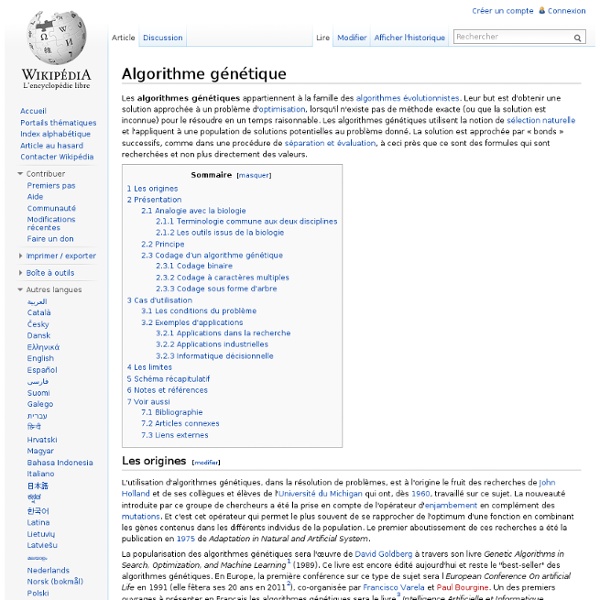Algorithme génétique

Genetic algorithm
The 2006 NASA ST5 spacecraft antenna. This complicated shape was found by an evolutionary computer design program to create the best radiation pattern. Genetic algorithms find application in bioinformatics, phylogenetics, computational science, engineering, economics, chemistry, manufacturing, mathematics, physics, pharmacometrics and other fields. Methodology[edit] In a genetic algorithm, a population of candidate solutions (called individuals, creatures, or phenotypes) to an optimization problem is evolved toward better solutions. Each candidate solution has a set of properties (its chromosomes or genotype) which can be mutated and altered; traditionally, solutions are represented in binary as strings of 0s and 1s, but other encodings are also possible. A typical genetic algorithm requires: a genetic representation of the solution domain,a fitness function to evaluate the solution domain. Initialization of genetic algorithm[edit] Selection[edit] Genetic operators[edit] Termination[edit]
Utilizing Genetic Algorithms to Identify Potential Software Performance Opportunities – Blogs
Tech Project #1: Utilizing Genetic Algorithms to Identify Potential Software Performance Opportunities In these blogs, I would like to discuss some of our failed technical projects at Intel in order to share some of the lessons we have learned. I am a believer that you learn just as much from your failures as from successes…so in these projects we learned a lot. This tech project ended back in 2004 and was absolutely fascinating. The parent and newly created children binaries were then compared in a bout of performance. One example of the random changes which was applied was a temporal locality hint which can be applied to loads or stores on the Itanium architecture. a) ld8 [r23] // Before temporal locality hint is applied as a mutation b) ld8.nta [r23] // After a temporal locality hint is applied as a mutation If this change increases the performance of the binary then that binary will win in the next contest and become the new parent binary…moved to the next round.
Related:
Related:



